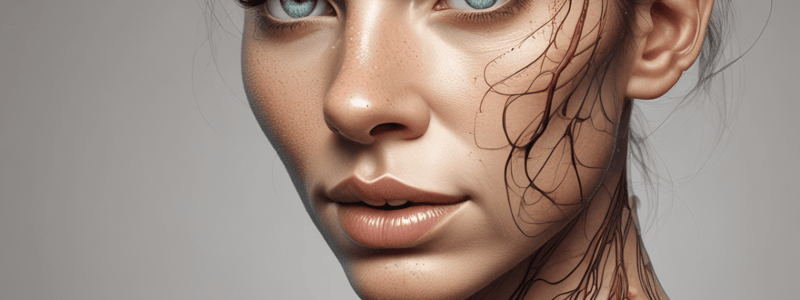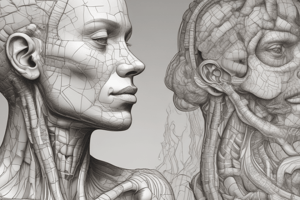Podcast
Questions and Answers
What is the skin divided into?
What is the skin divided into?
- Epithelial and connective tissue layers
- Superficial and deep layers (correct)
- Thin and thick layers
- Outer and inner layers
Where is the epidermis thick?
Where is the epidermis thick?
- In the face
- In the abdomen
- In the neck
- In the palm and sole (correct)
What is the dermis made of?
What is the dermis made of?
- Loose connective tissue
- Muscle tissue
- Dense connective tissue (correct)
- Fat tissue
What is found in the dermis?
What is found in the dermis?
What is the largest organ in the body?
What is the largest organ in the body?
What is the outermost layer of the skin?
What is the outermost layer of the skin?
What are Langer's lines and skin creases?
What are Langer's lines and skin creases?
What is the purpose of the lecture?
What is the purpose of the lecture?
What is the structure of the skin composed of?
What is the structure of the skin composed of?
What is the purpose of the intended learning objectives?
What is the purpose of the intended learning objectives?
What type of glands are present in the dermis and secrete sebum?
What type of glands are present in the dermis and secrete sebum?
What is the main function of skin creases?
What is the main function of skin creases?
What is the term for the natural orientation of collagen in the dermis?
What is the term for the natural orientation of collagen in the dermis?
What is the main difference between superficial fascia and deep fascia?
What is the main difference between superficial fascia and deep fascia?
What is a characteristic of superficial fascia in the scalp, back of neck, palm, and sole?
What is a characteristic of superficial fascia in the scalp, back of neck, palm, and sole?
Where is superficial fascia devoid of fat?
Where is superficial fascia devoid of fat?
What is a function of superficial fascia?
What is a function of superficial fascia?
What type of tissue makes up deep fascia?
What type of tissue makes up deep fascia?
What is the orientation of Langer lines in the trunk?
What is the orientation of Langer lines in the trunk?
What is a characteristic of skin creases?
What is a characteristic of skin creases?
What is a characteristic of deep fascia in terms of its development?
What is a characteristic of deep fascia in terms of its development?
What is the function of deep fascia in relation to muscles?
What is the function of deep fascia in relation to muscles?
Where does deep fascia form palmer and planter aponeurosis?
Where does deep fascia form palmer and planter aponeurosis?
What is another function of deep fascia?
What is another function of deep fascia?
What is the role of deep fascia in the neck?
What is the role of deep fascia in the neck?
What is the function of retinacula formed by deep fascia?
What is the function of retinacula formed by deep fascia?
What is the role of deep fascia in relation to veins?
What is the role of deep fascia in relation to veins?
What is the function of deep fascia in the fingers?
What is the function of deep fascia in the fingers?
What is the primary function of the hypothalamus in thermoregulation?
What is the primary function of the hypothalamus in thermoregulation?
What is the primary reason for the high number of sensory receptors in the face and fingertips?
What is the primary reason for the high number of sensory receptors in the face and fingertips?
What is the significance of the skin's ability to express emotions and behavior?
What is the significance of the skin's ability to express emotions and behavior?
What is the primary function of superficial fascia?
What is the primary function of superficial fascia?
What is the consequence of vitamin D deficiency in infants?
What is the consequence of vitamin D deficiency in infants?
What is the correct orientation of an incision in limbs for better healing?
What is the correct orientation of an incision in limbs for better healing?
What is the role of deep fascia in the body?
What is the role of deep fascia in the body?
What is the function of the skin in terms of absorption?
What is the function of the skin in terms of absorption?
Study Notes
Skin Layers
- Skin is divided into two layers: epidermis (superficial) and dermis (deep)
- Epidermis is thick in the palm and sole
- Dermis is made of dense connective tissue containing blood vessels, nerves, and lymphatics
Skin Appendages
- Nails are keratinized plates on the dorsal surface of fingers and toes
- Hair follicles, sweat glands, and sebaceous glands are present in the dermis
- Sweat glands are the deepest structure in the dermis
Skin Lines
- Skin creases are grooves opposite joints, where skin is thin and firmly adherent to underlying structures
- Langer's lines or cleavage lines correspond to the natural orientation of collagen in the dermis
- Incisions made parallel to Langer's lines heal better than those made across the lines
Fascia
- Fascia is a layer that lies beneath the skin, divided into two layers: superficial and deep
- Superficial fascia is a layer of loose connective tissue containing fat, firmly attached to the skin in specific areas
- Deep fascia is a membranous layer of connective tissue that invests muscles
Superficial Fascia
- It is devoid of fat in eyelids, auricle of the ear, penis, and scrotum
- It is rich in fat in the breast and gluteal region
- Functions of superficial fascia include:
- Facilitating movements of skin
- Being a bad conductor of heat
- Giving the body its shape
- Containing blood vessels, nerves, and sometimes muscles
- Holding skin firmly to deeper structures by bundles of collagen
Deep Fascia
- It surrounds muscles and is well-developed in limbs, thin in the thorax and abdomen, and absent in most of the face
- It forms:
- Plantar aponeurosis
- Palmar aponeurosis
- Retinacula
- Fibrous flexor sheaths
- Functions of deep fascia include:
- Covering muscles and assisting in their action
- Helping in venous return
Physiology of Skin
- Protection: against physical and chemical trauma, microorganisms, and radiations
- Thermoregulation: by negative feedback between skin, skeletal muscles, sweat glands, and hypothalamus
- Sensation: through high number of sensory receptors in the skin, especially in the face and fingertips
- Water storage: protection and maintenance of normal water and electrolyte levels
- Absorption: of drugs and toxic organisms
- Expression: the skin of the face can express emotions, behavior, and communication
- Synthesis of vitamin D: essential for bone health
Studying That Suits You
Use AI to generate personalized quizzes and flashcards to suit your learning preferences.
Related Documents
Description
This quiz covers the layers of skin, their contents, and different types of skin. It also covers Langer's lines and skin creases and their clinical significance.




